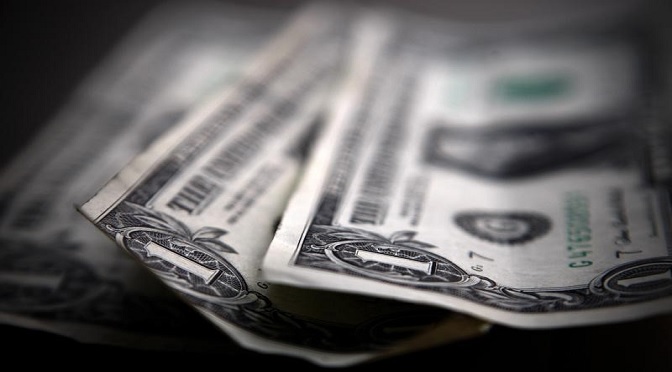-
Authoradmin
-
Comments0 Comments
-
Category
The U.S. dollar edged higher on Tuesday, pulling away from more than one week lows as indications that global trade tensions are easing helped push U.S. Treasury yields back above the key 3% level.
The U.S. dollar index, which measures the greenback’s strength against a basket of six major currencies, edged up 0.04% to 92.60 by 02:58 AM ET (06:58 AM GMT), moving away from Monday’s lows of 92.11, which was the weakest since May 2.
The dollar found support as the yield on 10-year U.S. Treasury notes ticked up to 3.025%, the highest level in three weeks. A rise above the high of 3.035% reached on April 25 would take it to its highest since early 2014.
U.S. bond yields were boosted by signs of easing trade tensions between the U.S. and China after U.S. President Donald Trump pledged to help Chinese technology company ZTE (HK:0763).
Last month, the Trump administration barred U.S. companies from selling to ZTE, effectively crippling the company.
A rally in the dollar, which hit four-and-a-half month highs against a currency basket last week, lost momentum after tame U.S. inflation data tempered expectations for a faster pace of rate hikes by the Federal Reserve this year.
The Fed raised rates in March and projected two more rate hikes this year, although many investors had seen three hikes as possible.
Investors were looking ahead to data on U.S. retail sales later in the day for signs of strength in the economy.
The dollar was higher against the yen, with USD/JPY up 0.22% at 109.89.
The euro was almost unchanged, with EUR/USD at 1.1926, holing below Monday’s highs of 1.1995, which was the most since May 3.
The euro touched the day’s highs on Monday after European Central Bank policymaker Francois Villeroy de Galhau said that the bank could give fresh guidance on the timing of a first rate hike as the end of its monetary stimulus program nears.
The pound was steady, with GBP/USD last at 1.3550 ahead of the latest UK jobs report later in the day.
Elsewhere, the Australian dollar was lower, with AUD/USD sliding 0.11% to 0.7517, while the New Zealand dollar was little changed, with NZD/USD last at 0.6910.
The Aussie and the kiwi had a muted reaction to a batch of Chinese economic data pointing to further slowing in economic momentum.
Recent Comments
- Starlight Herot on Euro Higher on German Data, Sterling Edges Lower
- Frost Dragont on Euro Higher on German Data, Sterling Edges Lower
- Gwinnettt on Euro Higher on German Data, Sterling Edges Lower
- Vanessat on Euro Higher on German Data, Sterling Edges Lower
- Christinet on Euro Higher on German Data, Sterling Edges Lower
Archives
- April 2025
- March 2025
- February 2025
- January 2025
- December 2024
- November 2024
- October 2024
- February 2024
- July 2023
- July 2021
- May 2021
- March 2021
- February 2021
- September 2020
- May 2020
- February 2020
- December 2019
- November 2019
- October 2019
- September 2019
- August 2019
- July 2019
- June 2019
- May 2019
- April 2019
- March 2019
- February 2019
- January 2019
- December 2018
- November 2018
- October 2018
- September 2018
- August 2018
- July 2018
- June 2018
- May 2018
- April 2018
- March 2018
- February 2018
- January 2018
- December 2017
- November 2017






